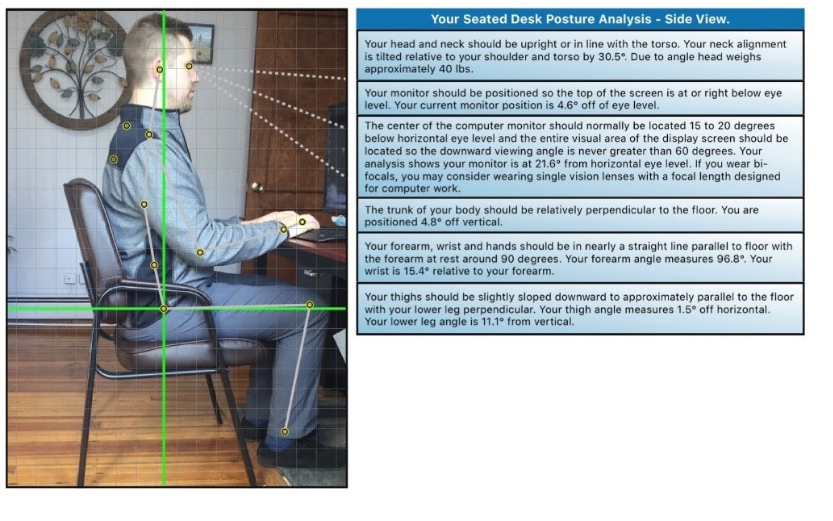By Billy Stetzel D.C.
With telecommuting and working from home on the rise, people are finding themselves sitting behind a computer more than ever before. Even before the majority of working people were thrust into a work from home situation, sitting behind a desk was a significant cause of aches, pains, and body dysfunction for the American work force. Maybe you even catch yourself in this position: shoulders caved in, back rounded, head jutting forward. The problem is, although the human spine is designed to last 100 years pain free, the habits we have developed as a society significantly diminish our health and make us more prone to injury.
The spine is composed of 24 moveable vertebrae 7 in your neck, 12 though your mid back, and 5 through your lower back, and the tailbone and pelvis are also part of your functional spine. The spinal column acts a protective housing for your delicate spinal cord as it comes down from the brain branching off into the nerves that connect to every organ, muscle, tissue, and cell in the body. Between each set of vertebra there is a shock absorbing cartilage cushion called the disc as well as muscles and ligaments that connect each of the bones allowing the body to move and stand upright. The spine is an incredible structure designed to have a gently curving S-shape to it which provides the maximum amount of flexibility and stability in the body. Unfortunately, the working conditions many are currently facing promote a forward slouching posture that can compromise the spines stability, integrity, and function.
When sitting for prolonged periods, it’s common for people to develop a specific posture in their body. The shoulders cave in, back rounds, head protrudes forward, putting the body into a C-shape. This position has a number of negative effects on the body. Some muscles become functionally short and stiff while others get functionally long and weak. The core abdominal muscles turn off leaving the small muscles around your spine, ligaments, and discs to support the entire body weight. Holding the extra weight weakens these structures, which is a major contributor to disc herniation. The psoas muscles that flex the hips become short and tight, so that even when standing they do not relax. The ribs collapse forward, closing down the diaphragm, making proper breathing more difficult. As the head comes forward and kinks the base of the neck, the tension increases in the spinal cord and nerves producing anything from numbness and tingling to neck pain and headaches.
The proper sitting position should include your head sitting directly over your shoulder and hip with your hips, knees and ankles flexed at 90 degree angles. Something to keep in mind, is that the head weighs an average of 10lbs. For every inch in moves forward in front of your body it adds an additional 10 pounds of pressure that the body needs to support. That is why after hours of computer work and video calls it be so exhausting for the neck and shoulders. As the upper body shifts forward, the pelvis tends to tilt backward, especially when sitting on soft surfaces like a sofa or cushioned chair. This causes a person to sit on their tail bone instead of the ischium bones that are designed for sitting. As the spine gets into this position it causes compression in the discs of the lower back. Research shows that 70% of “normal” asymptomatic people have disc prolapses that are pressing on nerve roots but no pain. That’s a problem just waiting to create a debilitating pain crisis.
So what are some things that can be done to see if this is a problem you’re experiencing? These are some suggestions you could use to determine if this poor sitting posture could be affecting you:
- Have someone take a picture of you working from a side view when you’re not paying attention. This will give a better view of what your natural working posture is.
- Take inventory of the areas you tend to experience discomfort. Do you feel discomfort across the tops of your shoulders, Neck pain, Headaches, Low back pain, Tight muscles in the chest and neck, trouble breathing deeply, or tightness in your hips?
- Schedule a virtual or in person consultation with a chiropractor. Chiropractors have the ability to analyze your posture and the alignment and integrity of your spine to help determine what is best action to take to support the health of your spine and nervous system.
- Talk to your personal trainer or physical therapist if you work with either. They may have noticed some of the postures that were discussed in this article and may be able to recommend exercises or techniques to help.
- Look at your work station where you currently spend the most of your time. Are you able to maintain 90-90-90 posture while seated? Are you sitting on a soft cushion surface for a firm surface that is better for your spine? Is your computer monitor or other device at eye level or do you need to look down at it?
While these suggestions are a good place to start, the best strategy is always to consult a professional first. Everyone has blind spots when it comes to physical health, and it can be nearly impossible to self- analyze where problems are arising. Follow these tips and make sure to reach out for help. Pain from sitting may be common but it does not have to be your normal.
By Billy Stetzel D.C. is a doctor of chiropractic at SoVita Chiropractic Center in Morristown, NJ. He Can be reached at dr.stetzel@sovitamorristown.com


